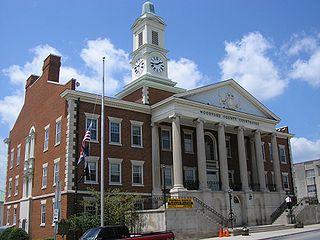| Spring Station | |
|---|---|
| Unincorporated community | |
| Coordinates: 39°9′14″N84°44′38″W / 39.15389°N 84.74389°W Coordinates: 39°9′14″N84°44′38″W / 39.15389°N 84.74389°W | |
| Country | United States |
| State | Kentucky |
| County | Woodford |
| Elevation | 814 ft (248 m) |
| Time zone | UTC-6 (Central (est)) |
| • Summer (DST) | UTC-5 (CST) |
| GNIS feature ID | 504150 [1] |
Spring Station, Kentucky is an unincorporated community in the northern part of Woodford County, Kentucky located approximately three miles west of Midway. The area is believed to have been settled during the early part of the 19th century and it became a station stop on the Lexington and Ohio Railroad line when it was opened through the village in 1833.

Woodford County is a county located in the U.S. state of Kentucky. As of the 2010 census, the population was 24,939. Its county seat is Versailles.

Midway is a home rule-class city in Woodford County, Kentucky, in the United States. Its population was 1,620 at the time of the year 2000 U.S. census. It is part of the Lexington-Fayette Metropolitan Statistical Area.
The Lexington and Ohio Railroad was the first railroad in the U.S. Commonwealth of Kentucky. Its charter proposed the establishment of a link between Lexington in the center of the Bluegrass Region to the river port of Louisville at the Falls of the Ohio by way of Frankfort, the state capital. The line was never completed and the Panic of 1837 led to its complete collapse. The Commonwealth seized the railroad in payment of its debts in 1840.
According to the University of Kentucky, it "was named for several nearby springs and may also have been known as Big Spring Station." [2] A postal outlet operated at Spring Station from 1856 to 1973.

The University of Kentucky (UK) is a public co-educational university in Lexington, Kentucky. Founded in 1865 by John Bryan Bowman as the Agricultural and Mechanical College of Kentucky, the university is one of the state's two land-grant universities, the largest college or university in the state, with 30,720 students as of Fall 2015, and the highest ranked research university in the state according to U.S. News and World Report.

The United States Postal Service is an independent agency of the executive branch of the United States federal government responsible for providing postal service in the United States, including its insular areas and associated states. It is one of the few government agencies explicitly authorized by the United States Constitution.
Spring Station was home to the Woodburn Stud, a thoroughbred and standardbred horse breeding operation built by Robert A. Alexander which became the birthplace of Kentucky's Thoroughbred industry.

Woodburn Stud was an American horse breeding farm located in Woodford County, Kentucky about ten miles (16 km) from the city of Lexington. It was established in the 18th century as an original land grant property of General Hugh Mercer to whom it had been granted for his military services during the American Revolutionary War. Robert Alexander (1767–1841), a Scottish immigrant, came to Virginia from Scotland in 1786. Around 1790 he purchased the Mercer estate in Kentucky. Under the guidance of his son, Robert A. Alexander, during the 19th century, Woodburn Stud became the birthplace of Kentucky's Thoroughbred industry.

The Thoroughbred is a horse breed best known for its use in horse racing. Although the word thoroughbred is sometimes used to refer to any breed of purebred horse, it technically refers only to the Thoroughbred breed. Thoroughbreds are considered "hot-blooded" horses that are known for their agility, speed, and spirit.

The Standardbred is an American horse breed best known for its ability in harness racing, where members of the breed compete at either a trot or pace. Developed in North America, the Standardbred is recognized worldwide, and the breed can trace its bloodlines to 18th-century England. They are solid, well-built horses with good dispositions. In addition to harness racing, the Standardbred is used for a variety of equestrian activities — including horse shows and pleasure riding — particularly in the midwestern and eastern United States, and southern Ontario.
In 1869, Daniel Swigert, who bred three Kentucky Derby winners, built a 300-acre (1.2 km2) thoroughbred horse breeding business at Spring Station he named Stockwood Farm.

The Kentucky Derby, is a horse race that is held annually in Louisville, Kentucky, United States, on the first Saturday in May, capping the two-week-long Kentucky Derby Festival. The race is a Grade I stakes race for three-year-old Thoroughbreds at a distance of one and a quarter miles (2.0 km) at Churchill Downs. Colts and geldings carry 126 pounds and fillies 121 pounds.













